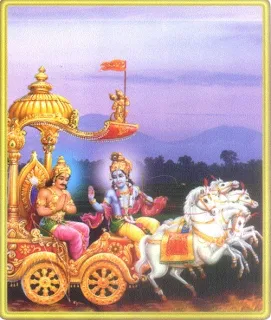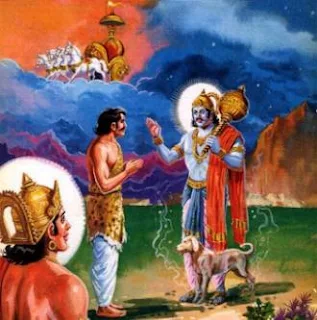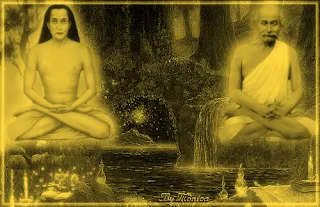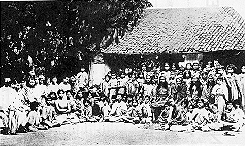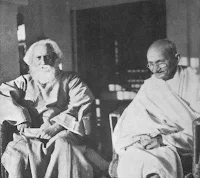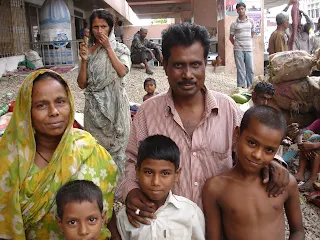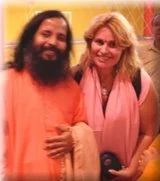C 1 v: 9, 10,11 e 12
anye ca bahavah surã
madarthe tyaktajivitãl
nãnãsastrapraharanãh
sarve yuddhavisãradah
And many other heroes extremely expert in fighting and well equipped with missiles and weaponns are here, willing to give up their lives for my sake ( 01:09)
E muitos outros heróis extremamente peritos no combate e bem equipados com mísseis e armas estão aqui, dispostos a dar suas vidas por minha causa (01:09)
aparyãptam tad asmãkam
balam bhismãbhiraksitam
paryaptam tv idam etesãm
balam bhimãbhiraksitam
Our army is meager and easy to conquer because it is guarded by Bhishma,but their army,guarded by Bhima,is unconquerable.(10)
Nosso exército é frágil e fácil de conquistar, porque ele é guardado por Bhishma, mas o seu exército, guardado por Bhima, é invencível (10).
ayanesu ca sarvesu
yathãbhãgam avasthitãh
bhismam evã bhiraksantu
bhavantah sarva eva hi
Therefore, protect Bhisma in particular,by all means,and stand firmly in front of your respective squads(11)
Portanto, vamos proteger Bhisma em particular, por todos os meios, e firmes na frente de seus respectivos esquadrões (11)
tasya sanjanayan harsam
kuruvrddad pitãmahah
simhanãdam vinadyo 'ccaih
sankham dadhmau prathãpavãn
In order to cheer up Duryodahyana,the aged grandfather of the Kurus,the very powerfull and highly dignifield granuncle,Bhishma, blew his conch shell nwith a loud war cry,like a lion.(12)
A fim de animar Duryodahyana, o avô idoso dos Kurus, o poderoso e altamente digno tio, Bhishma, soprou sua concha com um forte grito de guerra, como um leão (12)
The Kurus' army is our material and selfish instincts that impels us to act defensively and aggressively in favor of our egoistic desires and needs (represent the 5 energy centers beneath the skull): Who is ahead is Bhishma.
1- greed for money and material security
2- Sex for pure pleasure without responsibility and safety
3-the gluttony and the need for unbridled consumption,
4- The vanity, the ego and the arrogance and prejudice of creed, religion or appearance.
5 - religious sectarianism, sciences, ideologies and art, ethnocentrism
O exército dos Kurus são nossos instintos materiais e egoístas que nos impelem a agir de modo defensivo e agressivo em favor dos nossos desejos e necessidades egoísticas ( representam os 5 centros de energia abaixo do crânio): Quem está á frente é Bhishma .
1- a ganância pelo dinheiro e segurança material
2- o sexo por puro prazer sem responsabilidade e segurança
3- a gula e a necessidade de consumo desenfreada,
4- a vaidade, o ego e a arrogância e o preconceito de credo, religião ou aparencia.
5- o sectarismo religioso, das ciências , ideologias e arte, o etnocentrismo
The army of the Pandavas guarded by Bhima was invincible. Bhima is the loving discipline, it is the breathing controlled by the techniques of Kriya Yoga. So when the air passes through the energy centers of our body led by Lord Krishna if we have the devotion of Arjuna, we will also be invincible in the battle of life!
1-money will be used economically and for the common good.
2-sex will be sacred for the generation, creation and maintenance of families, couples and loving and fulfilled people.
3-Foods will be balanced and nutritious as well as our consumption limited to basic needs.
4-Negative and selfish emotions will be destroyed just like the individual ego, only the devotion and the sublime and dramatic virtues that are part of the spiritual life will have room.
5- respect for difference and the humility of being ready to learn and teach how a loving exchange for the common good will prevail.
O exercito dos Pandavas guardado por Bhima era invencível. Bhima é a disciplina amorosa, é a respiração controlada pelas técnicas de Kriya Yoga. Assim quando o ar atravessa os centros de energia do nosso corpo guiados pelo Senhor Krishna se tivermos a devoção de Arjuna , também seremos invencíveis na batalha da vida!
1-o dinheiro será utilizado com economia e para o bem comum.
2-o sexo será sagrado para a geração, criação e manutenção de famílias, casais e pessoas amorosas e realizadas.
3-os alimentos serão balanceados e nutritivos bem como nosso consumo limitado ás necessidades básicas.
4-As emoções negativas e egoístas serão destruídas assim como o ego individual, só a devoção e as virtudes sublimes e dramáticas que fazem parte da vida espiritual terão espaço.
5- o respeito á diferença e a humildade de estar pronto para aprender e ensinar como uma troca amorosa pelo bem comum vai prevalecer.
Every human body is the Baghavad Gita Paramahamsa Hariharananda Giri
Every human body is the Baghavad Gita Paramahamsa Hariharananda Giri
Cada corpo humano é o Baghavad Gita Paramahamsa Hariharananda Giri
I bow to God in all!
I bow to you!
Jai Gurudev!





